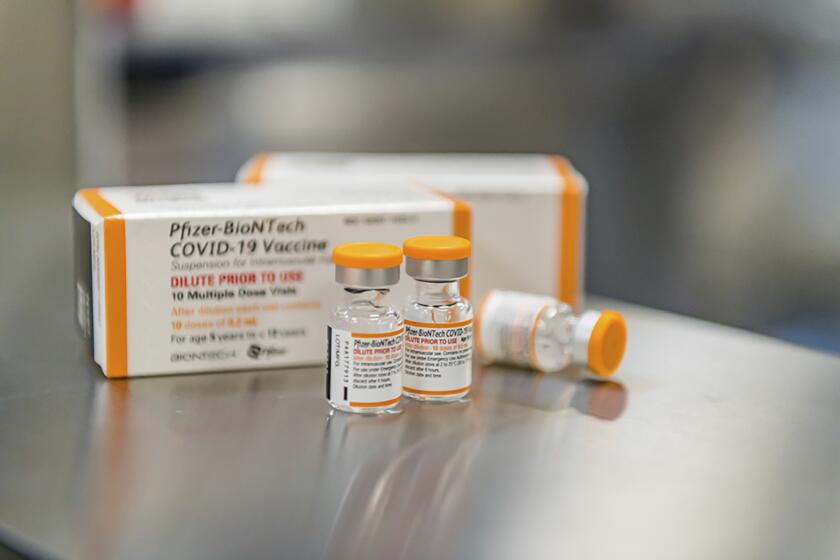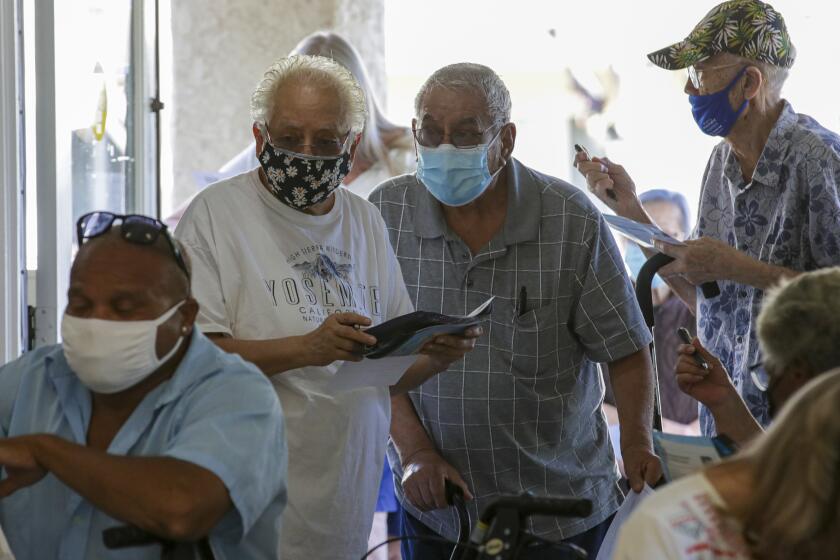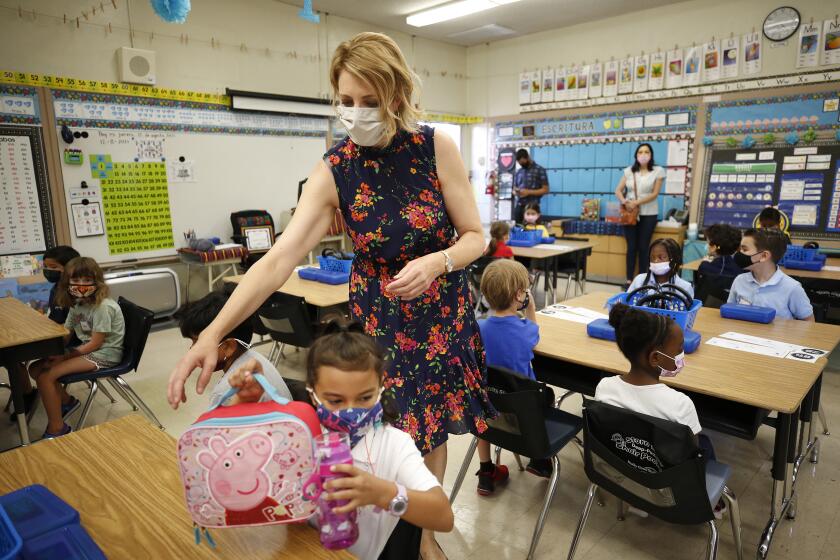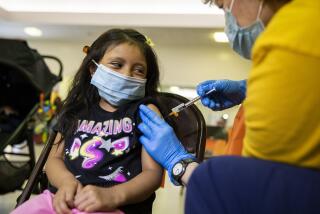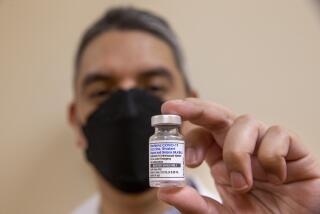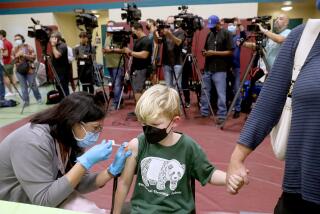California plans ambitious effort to vaccinate young children
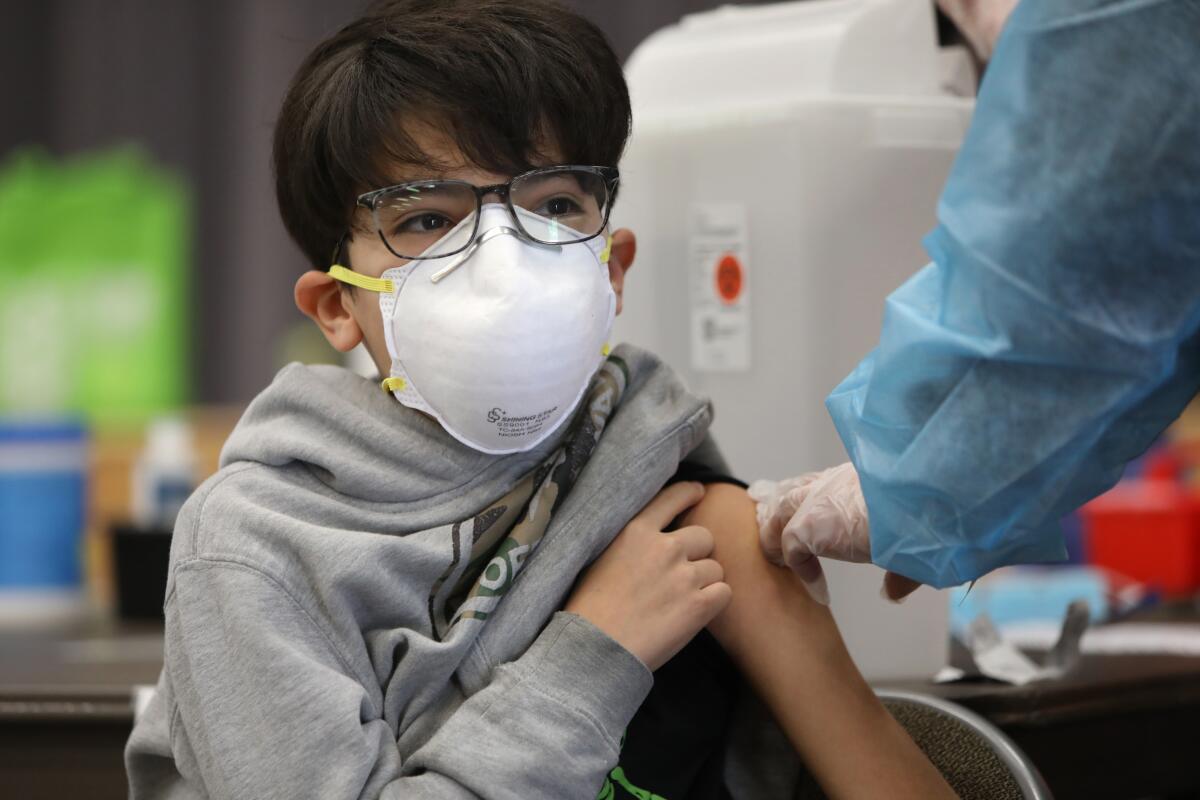
- Share via
California health officials said Wednesday that they are prepared to pull out all the stops to vaccinate children ages 5 to 11 against COVID-19 as the country draws closer to authorizing eligibility for that age group.
Though a number of federal and state hurdles remain, state officials said they are preparing to offer doses to the roughly 3.5 million children in that age group by the end of next week, as the holiday season approaches.
“The more vaccinations we get into the arms of eligible Californians, the more we stop the spread and shrink the pool of people vulnerable to COVID-19. This will get us closer to ending the pandemic,” said state epidemiologist Dr. Erica Pan. “Our youngest children have remained vulnerable to the highly contagious virus as older Californians have received their vaccine. Now the time is coming to protect them.”
Even though weekly cases, hospitalizations and deaths are declining, federal officials have warned that the nation has not yet achieved herd immunity.
“With cases still high, we must remain vigilant heading into the colder, drier winter months,” said Dr. Rochelle Walensky, director of the federal Centers for Disease Control and Prevention.
Walensky spoke favorably of the results of a clinical trial showing a vaccine efficacy rate of nearly 91% in preventing symptomatic COVID-19 cases in children between the ages of 5 and 11 who were not previously infected.
Children in this age group have a relatively low risk of hospitalization and death from COVID-19, leading some to question whether it’s worth vaccinating them at a time when the surge caused by the Delta variant appears to be fading.
The way to prevent more surges “is to get more and more people vaccinated,” Walensky said.
Though the early phase of California’s vaccination rollout was marred by scarce supplies, long lines and software mishaps, officials said they expect to have ample doses and capacity to handle expanded eligibility.
“We don’t anticipate any shortage of vaccine this time around,” said Dr. Marty Fenstersheib, the vaccine officer for Santa Clara County, Northern California’s most populous.
Pan, a pediatric infectious-disease specialist, said California will have more than 1.2 million doses available in the first week after younger children become eligible.
Though California already has a network of thousands of vaccination sites, officials said they are looking to work with schools to establish more on-campus locations — not just for any newly eligible children but also for parents who might be looking for a convenient site to receive their own shots.
A panel of U.S. health advisors endorsed kid-size doses of Pfizer’s COVID-19 vaccine, moving the U.S. closer to vaccinating children ages 5 to 11.
On Tuesday, a Food and Drug Administration advisory panel voted in favor of making kid-size doses of the Pfizer-BioNTech vaccine available.
The benefits of vaccinating children ages 5 to 11 outweighed the potential risks, such as a rare heart inflammation called myocarditis that has occurred in teens and young adults, the panel said.
A clinical trial for children in that age group found no reports of myocarditis post-vaccination, according to data presented to the FDA.
But the trial was relatively small, and ongoing monitoring for myocarditis cases will be needed.
Some experts have expressed optimism that the lower dosage for children ages 5 to 11 — a third of what older people receive — will reduce the chances of side effects.
The FDA is expected to make its own decision in the coming days. Should that agency sign off, the matter will next go to an advisory committee for the CDC, which plans to meet starting Tuesday.
The overall risk for kids is small, but COVID has become a leading cause of death for children, making vaccination as important as ever, experts say.
The committee’s recommendation will then go to the CDC director, Walensky, who will make a final recommendation on who should get the vaccine.
In California, shots won’t start going into youngsters’ arms until an additional review by the Western States Scientific Safety Review Workgroup, a coalition of public health experts from California, Nevada, Oregon and Washington. That review might take an additional day to complete.
Even so, it’s possible children ages 5 to 11 will be able to get their first dose of the Pfizer-BioNTech vaccine by the middle or latter part of next week.
Santa Clara County health officials said that under the most optimistic timeline, shots could be available by Wednesday or Thursday of next week.
Los Angeles County officials estimated that shots could be available late next week.
Based on that timeline, children could complete their two-dose vaccine regimen in time for the busy winter holiday season.
As with those ages 12 and older, the vaccine for this younger age group will be administered in two parts, with the second dose recommended by the manufacturer to be given three weeks after the first.
Because it takes two weeks following the second dose to be considered fully protected, the earliest cohort would be partly protected by Thanksgiving and fully protected by Christmas.
The Pfizer-BioNTech shot has already been fully approved for those who are at least 16 years old and is authorized for children ages 12 to 15 on an emergency basis.
Booster shots for eligible residents are expected to be widely available starting Saturday.
Vaccinating youngsters, officials say, will not only help prevent them from being stricken by the disease; it will also keep them from unwittingly spreading the virus to other, more vulnerable residents — and from incubating potentially dangerous coronavirus mutations.
“Fully vaccinated children will be better protected at schools, youth activities, holiday gatherings and celebrations, and homes,” Los Angeles County Public Health Director Barbara Ferrer said in a statement.
Children ages 5 to 11 make up roughly 9% of California’s population, and widely vaccinating them would substantially boost the state’s inoculation coverage.
Already, more than 68% of Californians have received at least one dose and about 62% are considered fully vaccinated, according to data compiled by The Times.
While much attention has been paid to boosters — which are now available to certain recipients of the Pfizer-BioNTech and Moderna vaccines, as well as everyone who got Johnson & Johnson — officials say getting more uninoculated residents to roll up their sleeves remains a top priority.
“We all want to be past this pandemic,” Gov. Gavin Newsom told reporters Wednesday, shortly after receiving his own Moderna booster, which followed his original J&J shot. “But we know the ticket out of this pandemic is getting these booster shots and getting the unvaccinated vaccinated. And we still have more work to do.”
The potential new front of the inoculation campaign comes as California is still combating vestiges of the latest coronavirus surge, fueled by the highly infectious Delta variant.
At the peak of the wave, California was confirming an average of nearly 15,000 new daily infections, and more than 8,300 COVID-19 patients were hospitalized statewide.
The number of coronavirus-positive patients hospitalized, 3,827 as of Tuesday, is largely flat from two weeks ago and has increased slightly over the last week.
On average, about 100 Californians are dying of COVID-19 each day.
Officials continue to stress that unvaccinated residents are bearing the brunt of the pandemic.
Unvaccinated Californians are more than six times likelier to be infected, 12 times more likely to wind up hospitalized and 18 times more likely to die than their vaccinated counterparts, said Dr. Mark Ghaly, the state’s health and human services secretary.
Federal health officials aren’t giving any specific recommendations, but there are options for COVID-19 boosters, and it’s OK if you mix vaccines.
Though children are, on the whole, far less likely than adults to suffer the worst health effects of COVID-19, the disease is not harmless for youngsters.
COVID-19 recently emerged as one of the top 10 killers of children ages 5 to 11. The CDC found that the 66 deaths recorded in the yearlong period that ended Oct. 2 made COVID-19 the eighth-leading cause of death among children in that age range.
The chance of dying of COVID-19 among children can be small yet still rank as a leading cause of death because children don’t die very often.
COVID-19 outbreaks have been increasing in L.A. County schools and programs in recent weeks, although not to the same extent as during last year’s autumn and winter surge.
As of mid-October, more than 6 million children in the U.S. had been infected with the coronavirus since the pandemic began, with 1 million of those cases recorded in the last six weeks.
“There simply is not an acceptable number of child deaths when such an effective and safe prevention [is] available,” Pan said.
More to Read
Sign up for Essential California
The most important California stories and recommendations in your inbox every morning.
You may occasionally receive promotional content from the Los Angeles Times.
